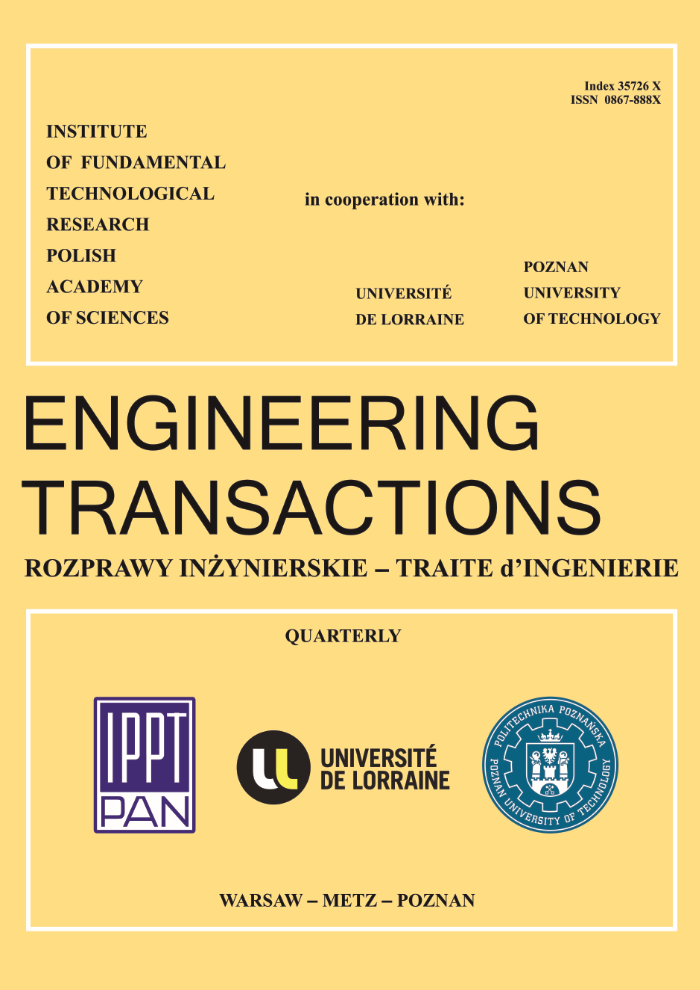Abstract
The paper presents compression test results of self-made open-cell aluminium which was produced by the investment casting method. Two groups of samples were studied: prototype samples containing some structural imperfections (apparent density 0.485 g/cm3) and regular samples without visible mistakes (app. density 0.312 g/cm3). Performed experimental research covered quasi-static compression tests with one hysteresis loop. Based on experimental results, new measures to help material characterisation were proposed: instant and average loop secant gradients ($E_{inst.sec}^{**}$ and $E_{av.inst.sec}^{**}$) and average linear loop gradient ($E_{av.lin}^{**}$).Keywords:
open-cell aluminium, aluminium sponge, compression test, loop gradientReferences
[1] Adamatis Ltd., Competiencies → Material Science → Application, [online, access: 10.10.2016], http://www.admatis.com/eng/metalfoam_application.htm.
[2] Lefebvre L.-P., Banhart J., Dunand D.C., Porous Metals and Metallic Foams: Current Status and Recent Developments. Advanced Engineering Materials, 10(9): 775–787, 2008, https://doi.org/10.1002/adem.200800241.
[3] Simancik F., Metallic foams – ultra light materials for structural applications, Inżynieria Materiałowa, 22(5): 823–825, 2001.
[4] Sobczak, J., Wojciechowski A., Boyko L., Drenchev L., Darłak P., Dudek P, Highly porous materials [in Polish], Instytut Odlewnictwa, Kraków, 2005.
[5] Banhart J., Manufacture, characterisation and application of cellular metals and metal foams, Progress in Materials Science, 46(6): 559–632, 2001, https://doi.org/10.1016/S0079-6425(00)00002-5.
[6] Degischer H., Kriszt B., Handbook of cellular metals: production, processing, applications, Wiley-VCH, 2002.
[7] Stręk A.M., Assessment of strength and functional properties of cellular materials [in Polish], doctoral thesis, to be submitted 2016.
[8] Ashby M., Evans A., Fleck N., Gibson L., Hutchinson J., Wadley H., Metal Foams: A Design Guide, Butterworth-Heinemann, 2000.
[9] ISO 13314:2011 Mechanical testing of metals – Ductility testing – Compression test for porous and cellular metals.
[10] DIN 50134:2008-10 Prüfung von metallischen Werkstoffen – Druckversuch an metallischen zellularen Werkstoffen.
[2] Lefebvre L.-P., Banhart J., Dunand D.C., Porous Metals and Metallic Foams: Current Status and Recent Developments. Advanced Engineering Materials, 10(9): 775–787, 2008, https://doi.org/10.1002/adem.200800241.
[3] Simancik F., Metallic foams – ultra light materials for structural applications, Inżynieria Materiałowa, 22(5): 823–825, 2001.
[4] Sobczak, J., Wojciechowski A., Boyko L., Drenchev L., Darłak P., Dudek P, Highly porous materials [in Polish], Instytut Odlewnictwa, Kraków, 2005.
[5] Banhart J., Manufacture, characterisation and application of cellular metals and metal foams, Progress in Materials Science, 46(6): 559–632, 2001, https://doi.org/10.1016/S0079-6425(00)00002-5.
[6] Degischer H., Kriszt B., Handbook of cellular metals: production, processing, applications, Wiley-VCH, 2002.
[7] Stręk A.M., Assessment of strength and functional properties of cellular materials [in Polish], doctoral thesis, to be submitted 2016.
[8] Ashby M., Evans A., Fleck N., Gibson L., Hutchinson J., Wadley H., Metal Foams: A Design Guide, Butterworth-Heinemann, 2000.
[9] ISO 13314:2011 Mechanical testing of metals – Ductility testing – Compression test for porous and cellular metals.
[10] DIN 50134:2008-10 Prüfung von metallischen Werkstoffen – Druckversuch an metallischen zellularen Werkstoffen.


